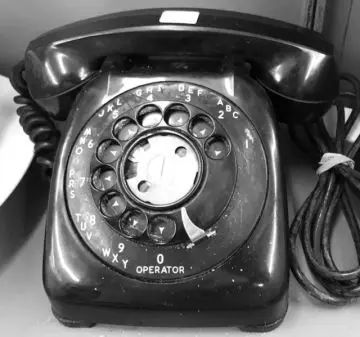
24 Things About To Become Extinct In America
24. Yellow Pages: This year will be pivotal for the Yellow Pages industry. Much like newspapers, they will continue to bleed dollars to their various digital counterparts, from Internet Yellow Pages (IYPs), to local search engines and combination search/listing services. The falloff in usage of newspapers and print Yellow Pages could even reach 10% this year – much higher than the 2%-3% fade rate seen in the past.
23. Classified Ads: The Internet has made many things obsolete. Newspaper classified ads might sound like just another trivial item on a long list. But this is one of those harbingers of the future that could signal the end of civilization as we know it. The argument is that if newspaper classifieds are replaced by free online listings at sites like Craigslist.org and Google Base, then newspapers are not far behind them.
22. Movie Rental Stores: While Netflix is looking up at the moment, Blockbuster keeps closing store locations by the hundreds. Movie Gallery, which owned the Hollywood Video brand, is gone. Countless small video chains and mom-and-pop stores have given up the ghost already.
21. Dial-up Internet Access: Dial-up connections have fallen from 40% in 2001 to 10% in 2008. The combination of an infrastructure to accommodate affordable high-speed Internet connections and the disappearing home phone have all But pounded the final nail in the coffin of dial-up Internet access.
20. Phone Landlines: According to a survey from the National Center for Health Statistics, at the end of 2007, nearly one in six homes was cell-only and, of those homes that had landlines, one in eight only received calls on their cells.
19. Chesapeake Bay Blue Crabs: Maryland’s icon, the blue crab, has been fading away in the Chesapeake Bay. Last year Maryland saw the lowest harvest (22 million pounds) since 1945. Just four decades ago the bay produced 96 million pounds. The population is down 70% since 1990. There are only about 120 million crabs in the bay and they need 200 million for a sustainable population.,
18. VCRs: For three decades the VCR was a best-seller. First decimated by the DVD, and now by the Digital Video Recorder (DVR), the only remnants of the VHS age at your local Walmart or Radio Shack are blank VHS tapes these days.
17. Ash Trees: In the late 1990’s the emerald ash borer hitched a ride to North America with ash wood products imported from eastern Asia. They’ve killed more than 30 million ash trees in southeastern Michigan alone, with tens of millions more lost in Ohio and Indiana and they continue to spread.
16. Ham Radio: Amateur Radio operators enjoy worldwide wireless communications with each other and are able to support their communities with emergency and disaster communications if necessary while increasing their personal knowledge of electronics and radio theory. In the past five years alone, the number of people holding active ham radio licenses has dropped by 50,000, even though code proficiency is no longer a requirement.
15. The Swimming Hole: Swimming holes are becoming a thing of the past. Swimming hole owners, like Robert Every in High Falls, N.Y., are shutting them down out of worry that if someone gets hurt, they’ll sue. And that’s exactly what happened in Seattle. The city of Bellingham was sued by Katie Hofstetter who was paralyzed in a fall at a popular swimming hole in Whatcom Falls Park.
14. Answering Machines: This is directly tied to the decline of landlines. The number of homes that only use cell phones jumped 159% between 2004 and 2007. In New York; since 2000, landline usage has dropped 55%. As cell phone usage goes up, the number of answering machines goes down.
13. Cameras That Use Film: In 2006, Nikon announced that it would stop making film cameras, pointing to the shrinking market – only 3% of its sales in 2005, compared to 75% of sales from digital cameras and equipment. That’s one example of many others doing the same thing.
12. Incandescent Bulbs: With the green movement and all-things-sustainable-energy crowd, the Compact Fluorescent Lightbulb (CFL) is replacing the incandescent bulb. 2007 sales for Energy Star CFLs doubled from 2006 and made up 20 percent of the U.S. light bulb market. And a new energy bill plans to phase out incandescent bulbs in the next four to 12 years.
11. Stand-Alone Bowling Alleys: 60 million Americans still bowl at least once a year, but few are bowling in stand-alone bowling alleys. Most new bowling alleys are part of facilities for multiple types of recreation. Lanes are also being added to adult communities, hotels, resorts, and gambling casinos.
10. The Milkman: In 1950, over half of the milk delivered was to the home in glass quart bottles, by 1963, it was about a third, and by 2001, it represented only 0.4%. Although some milkmen still make the rounds in small pockets of the U.S., they are certainly a dying breed.
9. Hand-Written Letters: In 2006, worldwide, 183 billion e-mails were sent each day, two million each second. By November of 2007, an estimated 3.3 billion Earthlings owned cell phones, and 80% of the world’s population had access to cell phone coverage. In 2004, half-a-trillion text messages were sent, and the number has increased exponentially since then. The art of handwritten letters is fading fast.
8. Wild Horses: 100 years ago, as many as two million horses were roaming free within the United States. In 2001, the wild horse population had decreased to about 50,000 head. Currently, there are 32,000 free-roaming horses in ten states, with half of them residing in Nevada.
7. Personal Checks: According to an American Bankers Assoc. report, a net 23% of consumers plan to decrease their use of checks over the next two years, while a net 14% plan to increase their use of PIN debit. On a bill-by-bill basis, checks account for only 49% of consumers’ recurring bill payments (down from 72% in 2001 and 60% in 2003).
6. Drive-in Theaters: During the peak in 1958, there were more than 4,000 drive-in theaters in this country, but in 2007 only 405 drive-ins were still operating. No new drive-ins have been built since 2005.
5. Mumps & Measles: In 1964, 212,000 cases of mumps were reported in the U.S. By 1983, this figure had dropped to 3,000. Prior to the measles vaccine, approximately half a million cases of measles were reported in the U.S. annually. In 2005, only 66 cases were recorded.
4. Honey Bees: Nothing on our list of disappearing America is so dire and so necessary to the survival of our food supply as the honey bee. ‘Colony Collapse Disorder,” or CCD, has spread throughout the U.S. and Europe over the past few years, wiping out 50% to 90% of the colonies of many beekeepers.
3. News Magazines and TV News: In 1984, the audience for all three network programs combined had declined to only 40.9 million viewers. Fast forward to 2008, and what they have today is half that.
2. Analog TV: 85% of homes in the U.S. get their television programming through cable or satellite providers. The remaining 15%, 13 million individuals, who are using rabbit ears or a large outdoor antenna to get their local analog stations need a new TV or a converter box to get the new stations, which will only be broadcast in digital 6 weeks from now.
1. The Family Farm: Since the 1930’s the number of family farms has been declining rapidly. 5.3 million farms dotted the nation in 1950, but this number had declined to 2.1 million by the 2003 farm census, and have continued to decline. Ninety-one percent of farms are small family farms.
